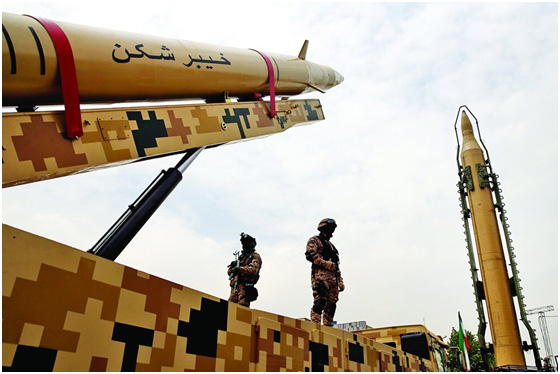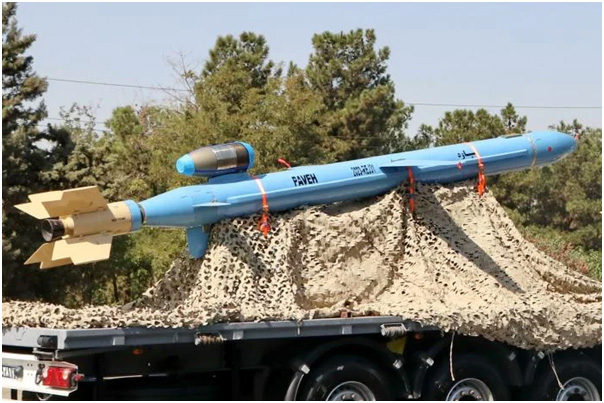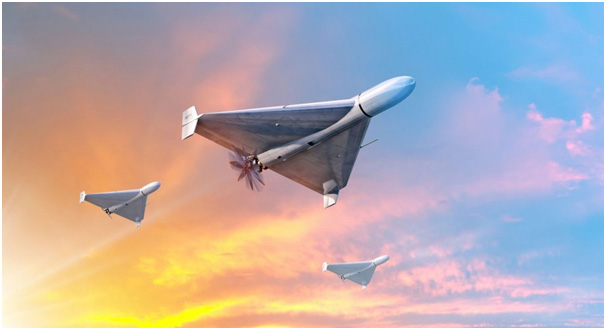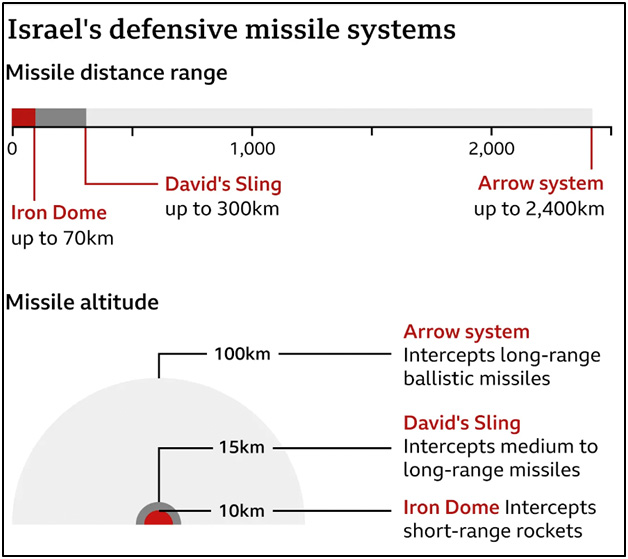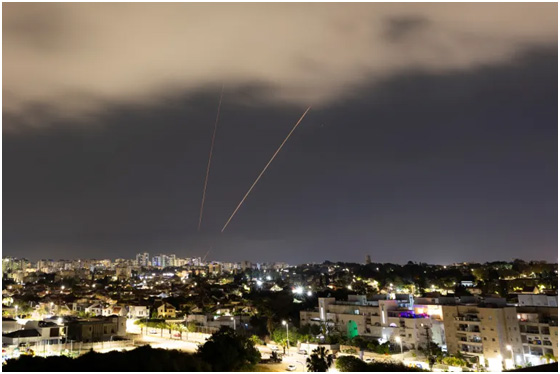
An anti-missile system operates after Iran launched drones and missiles towards Israel, as seen from Ashkelon on April 14, 2024
On 13 April 2024, Iran had carried out strikes against Israeli territory for the first time ever.The attack included 170 drones and 30 cruise missilesand at least 110 ballistic missiles. It was the largest ballistic missile attack to date. A large number of missiles and drones were shot down before they reached Israeli territory with at least one missile being intercepted outside the Earth’s atmosphere.[1]Iran’s attack was a response to an Israeli strike on a diplomatic compound in Damascus, which killed a high-ranking commander in Iran’s Islamic Revolutionary Guards Quds Force.
The attack was launched from Iran, Iraq, Syria and Yemen and only a small number of these projectiles reportedly reached Israel. To ensure that the drones and missiles reached their intended targets almost simultaneously, the ballistic missiles were fired almost an hour after the slower-moving drones.
According to Iranian state television, the missiles used in the attack were Emad long-range ballistic missiles and Paveh cruise missiles. The Emad long range missile, said to be an advanced version of the Shahab-3 ballistic missile, has a range of 1,700 km and can carry a payload of 750 kg. the changed design makes it possible for the warhead to detonate high above a target thus making it suitable for an air burst chemical, biological or nuclear weapon detonation. It is Iran’s first precision guided IRBM with an accuracy claimed to be of 50m though some reports claim that it has with 10 m accuracy. The missile also features a Manoeuvrable Re-entry Vehicle (MARV).
Emad Ballistic Missile
Paveh is a Soumar class cruise missile with a range of 1,650 km. The missile has the ability to take divergent paths to reach the goal as on reaching the target ittakes a circuitous path and attacks the target from a different direction. Reportedly, the missiles can be used for a massed attack wherein one missile acts as the leader, communicating with other missiles in the group as it guides them on to the target. Some reports even claim that it has hypersonic capability.
As Iran has one of the largest and most diverse missile arsenal in the Middle East, it is likely that other missile systems may also have been used in the attack.As per a BBC report quoting CBS, almost half of the 110 or so ballistic missiles fired by Iran, about half failed on launch or crashed mid-flight.
Paveh Cruise Missile
The drones used in that attack were the Shahed-136 kamikaze drones that carry a relatively small warhead weighing some 50kg and the Shahed-238. Of these, the 238 model is a turbojet powered drone with the speed of 600kmph.
Shahed Attack Drones
Besides Iran, missile and drones were also launched from Yemen, Iraq and Lebanon with Iran-backed Hezbollah group in Lebanon firing two barrages of rockets at an Israeli military base in the occupied Golan Heights.
The attack may have been the largest drone and missile attack but the barrage was successfully intercepted by the combined air defences including Israel’s Aerial Defense Array – the three-tier umbrella of missile defence systems. As some of the projectiles were launched from a relatively large distance, Israel could even employ its F-35s stealth fighters to intercept them. Israel even went on to claim that 99% of the incoming barrage was intercepted either outside Israeli airspace or over the country itself.
At the outer tier, the United States forces intercepted dozens of missiles and drones launched from Iran, Iraq, Syria and Yemen. Based on intel reports, the US had moved aircraft and warships to the region before the unprecedented attack and at least two aircraft and two destroyers were involved in intercepting the barrage. US Navy’s Aegis missile defence system shot down at least three ballistic missiles while a ballistic missile on its launcher and seven droneswere destroyed on the ground in Houthi-controlled areas of Yemen before they were launched. US forces shot down a number of Iranian drones over southern Syria near the border with Jordan with the US Central Command (Centcom) claiming that its forces had destroyed more than 80 drones and at least six ballistic missiles. On its part, Jordon destroyed a number of ‘flying objects’ over its airspace to ensure the safety of its citizens.The Royal Air Force also pitched in with its aircraft destroying a sizeable number of drones.
A large part of the barrage was intercepted by Israel’s missile defence system that has the Arrow system as the first tier of defence. It uses exo-atmospheric hypersonic anti-ballistic missiles to intercept long-range projectiles. It is believed that the Arrow missile system intercepted most of the ballistic missiles aimed at Israel with at least one of these missiles being shot down outside the Earth’s atmosphere.David’s Sling, the next tier, intercepted the medium to long-range ballistic missiles, cruise missiles and drones, taking them out as far as 300km away with the Iron Dome system taking on the projectiles in the innermost tier.
Given the unprecedented scale of the attack, a few ballistic missiles did get through and struck Israeli targets. Of these, four ballistic missiles hit the Nevatim air force base in the Negev desert in southern Israel and one hit a target in the North. The base houses the Israeli Air Force’s F-35 stealth fighters and It is believed that this was Iran’s primary target. The missiles though did not cause any major damage with only one missile hitting the runway. It is also believed that at least one missile was launched to take out a radar station in North Israel but it missed the target.
On 19 April 2024, Israel retaliated and carried out an attack on the Isfahan region in Iran. The region is home to significant Iranian military infrastructure, including a large air base, a major missile production complex and several nuclear facilities.Iran’s Fars news agency reported explosions near an army base but claimed that they were “due to air defence firing at suspicious objects” and that there was no damage.[2]
As Israel does not routinely confirm its military actions, it is difficult to ascertain the details though US officials have claimed that an Israel missile had been fired at Iran. Iran has however denied the use of a missile in the attack and has said that it only involved small drones, Media reports have claimed that a two-stage air launched missile had probably been used and more likely to be a Blue Sparrow missile.
Observations
Iran managed to carry out an air strike against Israel even though Israel enjoys formidable air superiority vis a vis Iran. In keeping with the changing times, the air attack was launched without employing any manned platforms. This is in line with the trend of relying more on unmanned platforms like missile and drones for air attacks.
The attack did not inflict significant infrastructural damage though that may have well been by design. It is likely that Iran wanted to make a statement by carrying out this attack and may not have intended to cause any large scale damage. Also, Iran may have carried out this attack with the aim of probing the Israeli defences and identify the strengths and weaknesses of its air defence system. Drawing on the lessons learnt, Iran will be able to carry out a more successful attack in the future- if it is compelled to.
Israel had warnings that the attack was coming, giving them crucial hours or days to ready air defences.Israel has acknowledged that the assistance provided by the United States, especially in terms of intelligence, was crucial to the successful interception of the Iranian projectiles. It is doubtful if Israel, without the warning and assistance from the United States would have managed to defend its territory.
A word about the claimed interception rate. Israel claims that it managed to intercept over 99 percent of the projectiles. This is much higher than the interception rate as seen in Ukraine which is just about 16 percent for ballistic missiles during recent large strikes.The numbers somehow do not add up in case of the Iranian attack. Consider the case of ballistic missiles. Almost all reports mention a figure of 110 to 120 missile being used in the attacks. The United States further claims that almost half failed at launch or disintegrated and fell mid-way. As at least that five(confirmed) ballistic missiles hit their targets, the Israeli claims of 99 percent interception, or even of 90 percent success rate are false and are just wild exaggeration.
It is possible that a large part of the drones may have been intercepted as even in case of Ukraine,about 75% of Russian cruise missiles and drones do get intercepted. Though a point to note is that many of those interceptions occur within the air defense umbrella that is also occupied with ballistic missile defense.[3] The success rate outside the missile defence coverage area may well be lower.
Israel claims that it was able to intercept almost all drones and missiles but it needs to be noted that it was not Israel alone that defended its territories – the United States, United Kingdom, France, and Jordan pitched in with their resources. It is doubtful if Israel alone could have intercepted such a large number of diverse types of projectiles
Manned aircraft were used to intercept missiles and drones,but this is possible only if there is adequate warning available and the interception takes place at a safe distance. Israel and its allies used hundreds of combat aircraft to intercept the projectiles launched by Iran.[4] Such a large effort is unlikely to be available in case of most countries, especially in case it is already at a state of war with its air force’s resources committed for other tasks/operations as well.
Israel could intercept the drones and missiles because of the approximately 1,000 km separating its borders with Iran. This luxury is not available for most countries and if a pre-emptive attack is launched from a relatively short distance, the drones and missiles may not provide any reaction time for aircraft to carry out such an intercept. On the contrary, launch site too close to the tactical battle area will, itself, be vulnerable and a target for air and artillery.
Even after claiming success interception of nearly all projectiles, the fact that a small number of large ballistic missiles did penetrate its defences should be a cause of concern for Israel as a well-directed future strike, probably by a hypersonic missile, against a key node can cause great damage. This has been demonstrated in Ukraine where Russia has managed to strike key infrastructure nodes with precise strikes, bypassing the Ukrainian air defences.Israel remains on target and should not get complacent.
The details of the Iranian attack available in the public realm may, as yet, be limited but they still offer an insight into the trends in employment of air power and need to be studied in details for the lessons it offers.
—————–
[1]Tom Spender, “What was in wave of Iranian attacks and how were they thwarted?’ BBC News, 16 April 2024
[2]Sean Seddon and Daniele Palumbo, “What we know about Israel’s missile attack on Iran,” BBC News, 20 April 2024
[3]“IRAN’S ATTEMPT TO HIT ISRAEL WITH A RUSSIAN-STYLE STRIKE PACKAGE FAILED…FOR NOW,” Institute for Study of War, 14 April 2024
[4]“US, UK and Jordan intercept many of the Iranian drones headed to Israel,” Times of Israel, 14 April 2024




